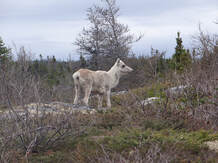Landscape Spatial Dynamics
Our lab is interested in a breadth of landscape-scale spatial dynamics: How do abiotic factors – things like temperature, precipitation, or soil conditions (i.e., bioclimatic or potential niche) – influence species presence? In turn, how do biotic interactions – things like predation, competition or mutualisms (i.e., realized niche) – determine where and when species are accessing natural resources? At what scale are abiotic or biotic factors more or less impactful on species distributions and connectivity? These questions have important implications in understanding the natural history, ecology, and appropriate management of wildlife. For example, both land use change and climate change are anticipated to alter some species' geographic locations. Yet we still do not know whether their biotic interdependencies, determined by their intra- and inter-specific interactions, will become unraveled (i.e., community disassembly) or if ecological communities will move as intact units. The goal of work in the Schmitz lab is to infuse greater consideration of biotic mechanisms—resolved with localized experimental research conducted in the field—into geographic scale modeling of species range distributions.
Animal drivers landscape biogeochemical patterns
Researcher: Kristy

Using computer-based simulations Kristy models how animals impact nutrient distribution at the landscape scale. Specifically, she has two projects, one which explore how caribou impact nitrogen concentrations at the landscape scale and one that explore how several ungulate species in Yellowstone shape nutrient distribution. Both models incorporate how animals remove nutrients through consumption, then return then via the deposition of waste material and carcasses. Such activities can shape landscape level nutrient patterns and create nutrient hotspots, alterations that could untimately help sustain large mammal populations
